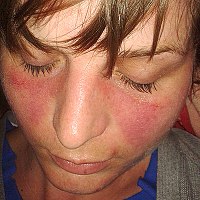
Photo from wikipedia
Objective To evaluate the rate of seroconversion to antinuclear-antibody negativity in patients with systemic lupus erythematosus and its association with subsequent systemic lupus erythematosus flare risk. Methods Medical records of… Click to show full abstract
Objective To evaluate the rate of seroconversion to antinuclear-antibody negativity in patients with systemic lupus erythematosus and its association with subsequent systemic lupus erythematosus flare risk. Methods Medical records of patients with systemic lupus erythematosus with positive antinuclear antibodies (titer ≥1 : 40) at diagnosis and at least one repeat antinuclear antibody test were reviewed. We determined the frequency of seroconversion to antinuclear antibody negativity among these patients and investigated whether seroconversion to antinuclear antibody negativity was associated with subsequent systemic lupus erythematosus flare risk. The seroconversion to antinuclear antibody negativity was defined as a conversion of positive antinuclear antibodies to a titer below the cut-off of 1 : 40. Systemic lupus erythematosus flare was defined as one new British Isles Lupus Assessment Group A or two new British Isles Lupus Assessment Group B domain scores. To estimate hazard ratios and 95% confidence intervals for systemic lupus erythematosus flare according to seroconversion to antinuclear antibody negativity, Cox regression analysis with adjustment for known systemic lupus erythematosus flare risk factors was performed. Kaplan-Meier analysis was used to compare flare-free survival rates between negative converters and non-converters. Results Among the total 175 patients, seroconversion to antinuclear antibody negativity was found in 17 (9.7%) patients in a median 53.5 (range: 25.7–84.0) months. After the last antinuclear antibody tests, 53 systemic lupus erythematosus flare cases were identified during 14.3 (range: 8.2–21.7) months of follow-up. Systemic lupus erythematosus flare risk was significantly lower in patients with negatively seroconverted antinuclear antibodies (adjusted hazard ratio 0.13, 95% confidence interval 0.03–0.58, p = 0.007). Kaplan-Meier analysis showed significantly higher flare-free survival in negative converters than in non-converters (p = 0.004). Conclusion Seroconversion to antinuclear antibody negativity occurred in 9.7% of patients over 53.5 months and was associated with a lower future systemic lupus erythematosus flare risk.
Journal Title: Lupus
Year Published: 2020
Link to full text (if available)
Share on Social Media: Sign Up to like & get
recommendations!